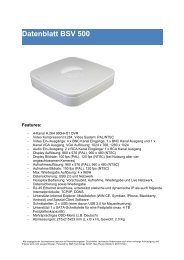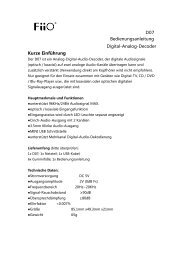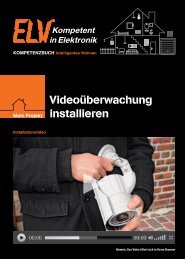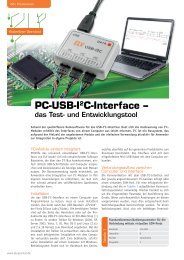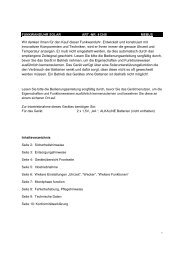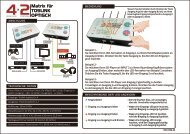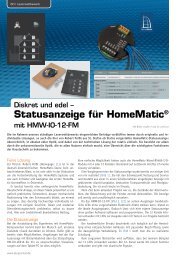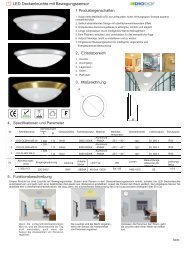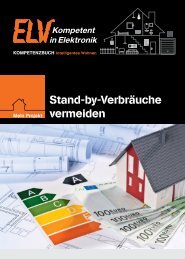PMF 180 E Multi - ELV
PMF 180 E Multi - ELV
PMF 180 E Multi - ELV
Create successful ePaper yourself
Turn your PDF publications into a flip-book with our unique Google optimized e-Paper software.
20 | English<br />
Operation<br />
Starting Operation<br />
� Observe correct mains voltage! The voltage<br />
of the power source must agree with the<br />
voltage specified on the nameplate of the<br />
machine. Power tools marked with 230 V<br />
can also be operated with 220 V.<br />
Switching On and Off<br />
To start the machine, push the On/Off switch 1<br />
forward so that the “I” is indicated on the<br />
switch.<br />
To switch off the machine, push the On/Off<br />
switch 1 toward the rear so that the “0” is indicated<br />
on the switch.<br />
Preselecting the Orbital Stroke Rate<br />
With the thumbwheel for preselection of the orbital<br />
stroke rate 2, you can preselect the required<br />
orbital stroke rate, even during operation.<br />
The required stroke rate depends on the material<br />
and the working conditions and can be determined<br />
through practical testing.<br />
Working Advice<br />
Note: Do not cover off the venting slots 5 of the<br />
machine while working, as this reduces the<br />
working life of the machine.<br />
While working with HCS tools make sure that<br />
the covering of the tools is undamaged.<br />
Operating Principle<br />
Due to the oscillating drive the application<br />
tool/accessory swings up to 21000 times per<br />
minute for 2,8°. This allows for precise work<br />
in narrow spaces.<br />
Sawing<br />
� Use undamaged faultless saw blades only.<br />
Deformed, blunt saw blades or saw blades<br />
that are otherwise damaged can break.<br />
� When sawing light building materials, observe<br />
the statutory provisions and the recommendations<br />
of the material suppliers.<br />
� Plunge cuts may only be applied to soft<br />
materials, such as wood, gypsum plaster<br />
boards, etc.!<br />
Before sawing with HCS saw blades in wood,<br />
particle board, building materials, etc., check<br />
these for foreign objects such as nails, screws,<br />
or similar. If required, remove foreign objects or<br />
use BIM saw blades.<br />
Separating<br />
Note: When separating wall tiles take into consideration<br />
that the application tools/accessories<br />
wear heavily when used for longer periods<br />
of time.<br />
Sanding<br />
The removal rate and the sanding pattern are<br />
primarily determined by the choice of sanding<br />
sheet, the preset oscillation rate and the applied<br />
pressure.<br />
Only flawless sanding sheets achieve good<br />
sanding capacity and extend the service life<br />
of the machine.<br />
Pay attention to apply uniform sanding pressure;<br />
this increases the working life of the sanding<br />
sheets.<br />
Intensifiying the sanding pressure does not lead<br />
to an increase of the sanding capacity, but to increased<br />
wear of the machine and the sanding<br />
sheet.<br />
For precise on-the-spot sanding of edges, corners<br />
and hard to reach areas, it is also possible<br />
to work only with the tip or an edge of the sanding<br />
plate.<br />
A sanding sheet that has been used for metal<br />
should not be used for other materials.<br />
Use only original Bosch sanding accessories.<br />
For sanding, always connect dust extraction.<br />
Scraping<br />
For scraping, select a high oscillation rate.<br />
Work on a soft surface (e.g. wood) at a flat ange,<br />
and apply only light pressure. Otherwise the<br />
scraper can cut into the surface.<br />
2 609 000 229 | (19.1.09) Bosch Power Tools



